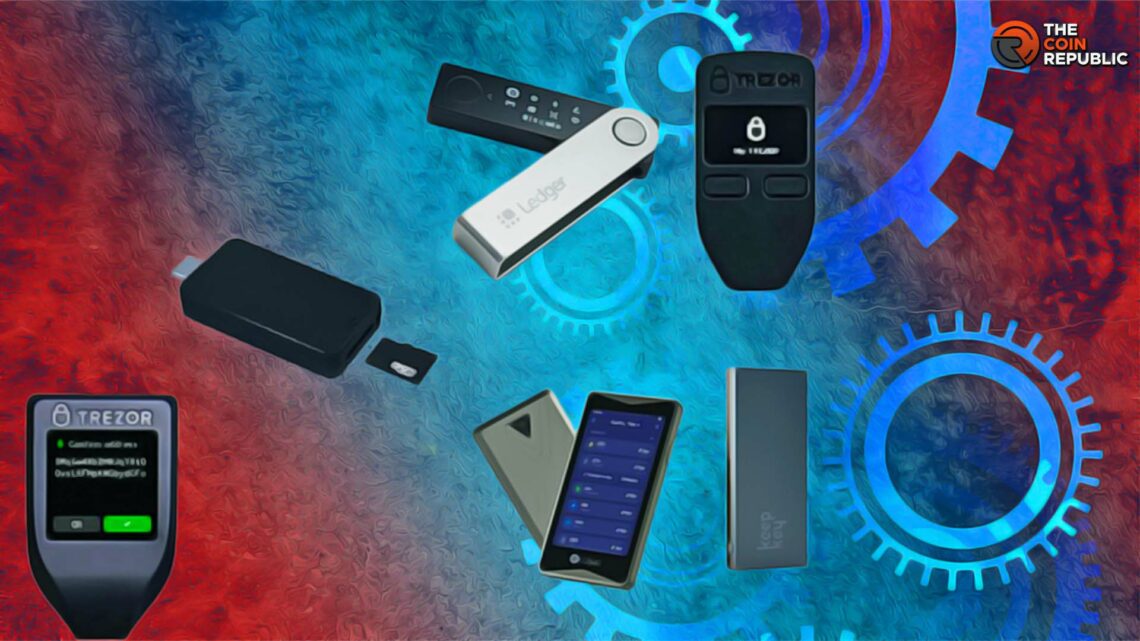- 1 A hardware wallet is a physical device offering a secure and convenient way to store, manage and access funds.
- 2 The private keys stored over the offline platform offer a secure way to store digital assets and make wallet usage more convenient.
Technological advancement raised cyber crimes and enhanced harmful actions committed with the purpose of stealing, destroying, or disrupting data. Upsurge in cyber threats made it essential for the crypto market to protect the digital asset using Crypto hardware wallets. The first-ever hardware wallet named Ledger Nano S. was launched in 2016 by Ledger. The wallet was mainly used to buy, secure and manage crypto assets and is retailed at $59.00. Tezor Model T-Next Generation, SafePal S1, ELLIPAL Titan, BitBox, and Ledger are some best hardware wallets used in the crypto market.
How do Crypto Hardware Wallets Work
Secure microcontrollers, display screens, and input buttons are the three main physical components of the crypto hardware wallet and help to connect to a mobile or computer using USB. The wallet is not accountable to store the cryptos itself, but the keys that access it.
The working of the hardware wallets relies on the public and private keys. Both the key pairs are core components of public key cryptography which is an encryption mechanism safeguarding data from unauthorized access. The keys in combination are majorly used for encrypting and decrypting messages and transactions.
The keys are a long line of numeric values and are related to one another, and the public key is only decrypted in correspondence with the private key. Private keys, on the other hand, help an individual access, send, and receive digital assets in a trustworthy manner without the need for any verification. The keys are mainly kept secured as if an individual loses a private key, the chances of losing their wallet increase along with enhanced chances of economic loss.
This is one of the main reasons that private keys are stored offline protecting digital assets from hacking. The input buttons available on the hardware wallet help in navigating the device menu and making selections. Display screens on the other hand contribute to interacting with the hardware wallet. Some hardware wallets use USB whereas some have Bluetooth capabilities allowing wallets to connect wirelessly.
Focusing on sending and receiving money, connecting the device with the computer system or mobile, and following the prompts on the display screen helps in initiating a transaction.
Benefits of Using Hardware Wallets
Around 5 Million users at present are using the crypto hardware wallet and around 295 Million crypto holders decided to include hardware wallets in their portfolio. High security, total control, and trustworthy infrastructure are some major benefits of hardware wallets.
The device keeps the private keys completely offline and secured and allows users to completely control their accounts. Also, the utilization of the wallet is easy and offers a user-friendly interface making the wallet convenient to use.
Conclusion
A crypto hardware wallet is a physical device that stores private keys over an offline platform and helps in safeguarding digital assets. The overall working of the wallet relies on the private and public keys that contribute to encrypting and decrypting the message as well as the transactions.

Nancy J. Allen is a crypto enthusiast, with a major in macroeconomics and minor in business statistics. She believes that cryptocurrencies inspire people to be their own banks, and step aside from traditional monetary exchange systems. She is also intrigued by blockchain technology and its functioning. She frequently researches, and posts content on the top altcoins, their theoretical working principles and technical price predictions.


 Home
Home News
News








